Gulbenkian Museum to close for renovations until 2026
Around 200 medium- and small-scale works from the museum’s collection will be displayed between April and September 2025 at the Gulbenkian Foundation’s headquarters.

What?
The Calouste Gulbenkian Museum in Lisbon will close its doors for renovations starting March 18, 2025, and remain shut until July 2026, the Gulbenkian Foundation announced on Monday.
During this period, from April 11 to September 1, approximately 200 pieces from the museum’s renowned collection will be displayed in the gallery on the lower floor of the foundation’s headquarters.
Among these works will be several iconic pieces from what is considered one of the most extraordinary collections assembled by a single individual in the first half of the 20th century, spanning over 5,000 years of history, from antiquity to the 20th century.
Renovation Goals
In a statement, the foundation detailed the scope of the renovations, which aim to modernize the museum’s climate control, lighting, and security systems to meet current conservation and exhibition standards.
The updates will also address the increased volume of visitors, with the goal of enhancing the visitor experience. António M. Feijó, the foundation’s president, noted that the project will harmonize the museum’s various galleries, which have undergone piecemeal changes over the years. This effort seeks to restore the original vision of the museum while improving clarity and accessibility for visitors.
French architect Frédéric Ladonne and Portuguese architect Teresa Nunes da Ponte, who previously oversaw the renovation of the foundation’s auditorium, are the authors of the project to revitalize the Calouste Gulbenkian Museum.
“Our goal is to refresh the museum without making significant changes to its exhibition narrative, which is already well-defined around the key pieces Gulbenkian collected throughout his life,” said António Filipe Pimentel, the museum’s director, in an interview with PÚBLICO.
Pimentel noted that the mandatory closure for the installation of energy-efficient LED lighting, air conditioning upgrades, and security improvements also presented an opportunity to rethink how the founder’s collection is presented to visitors.
“Until now, Calouste Gulbenkian has been almost absent from the museum. What we want is to bring him into the narrative, integrating research conducted by Vera Mariz, who has been deeply studying the figure of the collector,” he added.
The museum, under the leadership of António Filipe Pimentel, will also use the closure period to restore and study several paintings. This work will be carried out in collaboration with the HERCULES Laboratory at the University of Évora.
A History of Renewal
This will be the first time in its 56-year history that the museum will undergo extensive renovations affecting all its galleries simultaneously, as well as the offices housing its teams. This monumental undertaking will necessitate the temporary relocation of its collection.
Therefore, around 200 medium- and small-scale works from the museum’s collection will be displayed between April and September, titled “Gulbenkian Collection: Masterpieces,” in the secondary gallery for temporary exhibitions at the Gulbenkian Foundation’s headquarters, located right next door.
The exhibit highlights the idea that an artwork’s significance isn’t determined by its size.
“The temporary gallery we’re using [on the lower floor of the foundation’s headquarters] has a much lower ceiling than the museum, so larger-scale pieces couldn’t be displayed there,” Pimentel explained. “That’s why we chose to shine a spotlight on smaller works that might otherwise go unnoticed.”
This creative solution ensures that the essence of the Gulbenkian collection remains accessible to the public, even as the museum undergoes its transformative reimagining.
The Gulbenkian Foundation recently completed a similar renovation project with the reopening of its Modern Art Center in September 2024. After four years of closure, the center now features an additional 900 square meters of exhibition space.
The Calouste Gulbenkian Museum houses one of the world’s most important private art collections. It includes works from Ancient Egypt to the early 20th century, spanning the arts of the Islamic World, China and Japan, as well as the French decorative arts, the jewellery of René Lalique and some of the most important painters of all times works such as Rembrandt, Monet, Rubens, Manet, Renoir, Degas and Turner.



